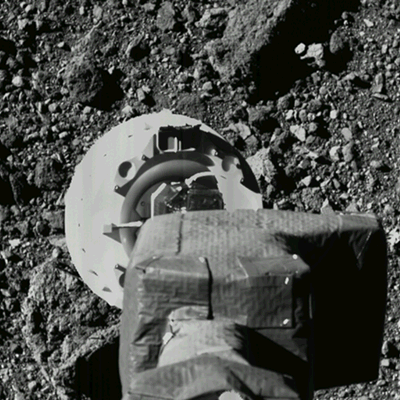What's the truth of it? Well, the answer may indeed be out there; just don't expect to find it by asking a Hollywood screenwriter. To discover the real truth, you'd either need to talk to a working astronomer, or get yourself a pair of very powerful binoculars. Not the kind you can buy at a shopping mall, mind you, but rather one with lenses 28 feet wide.
Believe it or not, such a binocular actually exists. Called the Large Binocular Telescope (LBT), this $120 million, 500-metric-ton instrument is now in place atop Mount Graham, east of Tucson. Currently the most powerful telescope in the world, the device, using two giant 8.4-meter mirrors working in tandem, will soon be able to peer deeper into the past, and with better clarity, than the Hubble Space Telescope.
Project director Dr. Richard Green said viewing will be limited "primarily to those astronomers in the partner institutions that funded the project." So unless you're a qualified scientist from the University of Arizona or one of its partners, good luck trying to use the telescope.
Even for astronomers, finding time on a major telescope can be tough. As Dr. Green put it, "The current demand so exceeds availability that only one project in six or eight actually wins time competitively."
Different research projects also demand different types of telescopes. "Many telescopes are specialized to record celestial radiation in different ways," said Dr. Green. This includes not just visible light, but infrared and ultraviolet radiation, plus X-rays, gamma rays and simple radio waves. "Then you have the Large Synoptic Survey Telescope (LSST), also being designed in Tucson, but with a much wider field of view than the LBT so that it can capture the night-to-night changes in faint objects to find moving asteroids and distant exploding supernovae. To continue the pace of discovery, we simply need more telescopes, like biologists need more microscopes."
And in another nod to Southern Arizona, when institutions need the mirrors used in telescopes like the LBT, the LSST or the upcoming Giant Magellan Telescope, they come to Tucson, on campus at the UA's Steward Observatory Mirror Lab--a state-of-the-art facility that casts the massive slabs of glass destined to answer some of science's ultimate questions.
Here in this impressive room, behind the university's Flandrau Science Center, a huge furnace heats 20 tons of glass, gently spinning it into a parabolic shape at 2,130 degrees Fahrenheit, before cooling and polishing it to an accuracy that's about 3,000 times thinner than a human hair. Finally, a coating of reflective aluminum is applied, and the lighter-weight mirror or mirrors are then transported to the telescope site.
Arizona is a prime place for telescopes, as are spots in Chile, Hawaii and the Canary Islands, because of four needed attributes, according to Dr. Green: clear skies, dark skies, naturally sharp celestial imaging and low water vapor.
"Southern Arizona has an average of about 75 percent clear hours over the course of a year, and Mount Graham is distant enough from Tucson and Phoenix that the growing light pollution from those metro areas has less impact," Green said. "All the high peaks in Southern Arizona actually deliver sharp images when the weather is stable, but the high altitude of Mount Graham gives especially low water vapor, of particular value for infrared observations, where water in the atmosphere can absorb celestial radiation."
The three telescopes now atop Mount Graham--the LBT, the Heinrich Hertz Submillimeter Telescope and the Vatican Observatory Telescope--represent the completion of only the first phase of development. More scopes will be coming, Green said. Indeed, the initial vision called for some seven major telescopes on the site, but the UA will need to formulate an approach with the U.S. Forest Service for the next phase, with environmental concerns a factor.
That's not to say the Kitt Peak National Observatory has been left behind.
"As a mature facility with moderate aperture telescopes, Kitt Peak observatories are assuming a new and complementary role in astronomy," Green said. "Their two largest telescopes have mirrors of about 4 meters, with very wide fields of view, and are used more for surveying large areas of the sky for rare objects that can then be followed up with the truly giant telescopes like LBT. Kitt Peak also hosts a number of smaller telescopes run by university consortia that support the long-term projects of their faculty and students."
Indeed, many astronomers at the UA benefit from Kitt Peak data now, and will from LBT data, too. Like Xiaohui Fan, who holds the record for discovering the most distant quasars, and is ready to start his next survey with LBT. Or Phil Hinz, who is working with NASA support to achieve super-Hubble resolution for detection of extra-solar planets. Green himself has been studying quasars and black holes since his own graduate-student days, when he was a member of the science team that built the Hubble Space Telescope instrument that surveyed nearby giant galaxies, and verified a black hole at the center of every one of them.
Meanwhile, excitement over the LBT's possibilities continues to grow. "The LBT can make images sharp enough to resolve a football at a distance of 4,000 miles," said Dr. John Hill, LBT's technical director. "So if it weren't for the curvature of the Earth, you could use it to watch Steelers games in Pittsburgh."












